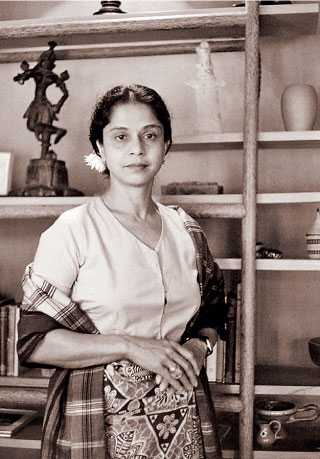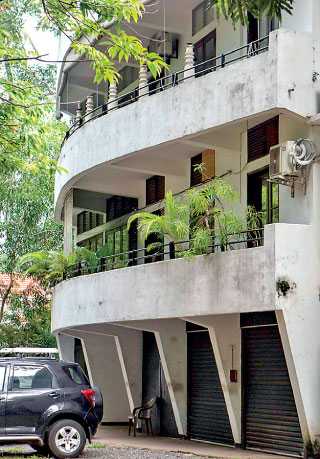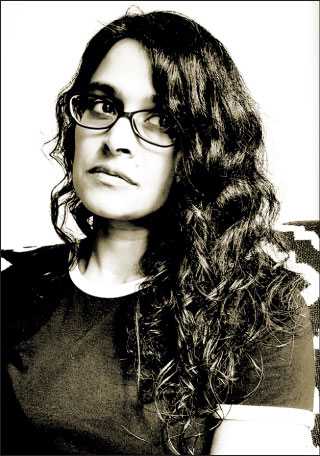Monday Apr 21, 2025
Monday Apr 21, 2025
Wednesday, 3 June 2020 00:00 - - {{hitsCtrl.values.hits}}
For any writer, having a fascinating subject around whose life one can build a story on is an advantage. When the subject happens to be Minnette de Silva, a trailblazing woman who lived well ahead of her time and reached the zenith of her career as an architect, it is even more so.
For author Shiromi Pinto, who recently released her book titled ‘Plastic Emotions,’ a story she’s woven around the life of this fascinating character, there was instant intrigue when she first heard of Minnette De Silva and in particular her close relationship with Swiss-French architect Charles-Édouard Jeanneret, better known as Le Corbusier, a pioneer in modern architecture.
Minnette remained ingrained in Shiromi’s mind for a long, long time before she began researching life of woman who was the first Asian woman to become an Associate of the Royal Institute of British Architects. Minnette was the daughter of politician and suffragist George E. De Silva, the first Cabinet Minister of Industries, Industrial Research and Fisheries in independent Sri Lanka.
While she made great strides in her chosen field of architecture, leading a non-conformist life, Minnette’s life was also tragic. ‘Plastic Emotions’ takes one through the love affair between Minnette De Silva and Le Corbusier, two real people, who have been brought to life by the author by mixing fact with fiction that makes the book a gripping read.
In an email interview Shiromi Pinto told the Daily FT why she was attracted to the Minnette De Silva›s story and the years of painstaking research she put in before ‘Plastic Emotions’ became a reality.
By Chandani Kirinde
Q: What fascinated you so much about Minnette’s life that you decided to write a book on her?
When I first heard of Minnette de Silva, I was fascinated. Here was this woman who was absolutely at ease with all these great minds of the 20th century. Among her friends were Le Corbusier, father of modern architecture, French photographer Henri Cartier-Bresson, writer Mulk Raj Anand, poet Sarojini Naidu. It seemed extraordinary to me that she was not better known – that I had never heard of her before. Her social circle, coupled with her visionary architectural thinking, rendered her life and work an ideal springboard for a novel. There was a lot I wanted to say about that period of Sri Lanka’s history as well, and she was perfectly situated for me to tell that story.
 |
| Minnette de Silva |
 |
| Senanayake Flats, Gregory's Road , Colombo |
 |
| Shiromi Pinto
|
Q: How/ when did you first come upon her story?
I first discovered Minnette through a friend of mine who worked for her in the 1980s. Whenever we met, conversation would turn to this remarkable woman, her thinking and her social set, and my mind’s eye would fill with so many vivid scenes. It was a gift, really.
What really intrigued me at the start was the idea that this woman from a little-known country like Sri Lanka should have commanded the attention of an architectural giant like Le Corbusier. The mystery surrounding their relationship gave me space to build a story, and then, of course, there was Minnette’s own brilliant ideas which are very much foregrounded in my novel as well.
Q: When did the project start? It must have taken a great deal of research to complete the book.
I am almost embarrassed to say when I started! It was a long, long time ago. I weathered a lot of personal milestones while researching and writing the book. It took me 10 years! I was researching and writing between working full-time, raising a child and so many other things. I could not work on it every day.
The research did take ages. I spent many months, indeed years, in the British Library, and the now-defunct British Newspaper Library, during my desk research phase. It was painstaking but fun. I vividly recall being six to seven months pregnant, going through old newspapers in Colindale (where the British Newspaper Library once stood) and having to step out frequently to use the toilet or grab a snack. In truth, I was preparing to birth two children – one human, the other…
Q: The exchange of letters between Corbu and Minnette make up a large part of the book. They also show her flair for writing. Any thoughts on that aspect?
The letters in the novel are of course fiction, although they are rooted in Minnette and Corbu’s actual correspondence. Minnette certainly had a particular way of expressing herself, but this correspondence is imagined – and, yes, I’ve given her a flair for writing that is based on what I have seen in her letters, her articles and her fantastic autobiography, ‘The Life and Work of an Asian Woman Architect’.
Q: You say the book is a work of fiction, but the two main characters are real people. Would you say more of it is fact than fiction?
Yes, the book has two main characters who are real people. Writers do this kind of thing all the time – there are works of historical fiction, there are works that play with known characters to hilarious effect. That’s the freedom of fiction. So, although there are plenty of facts in the book, this is a literary work. It’s a work of fiction and should always be read as such.
Q: She was obviously a woman ahead of her time. What inspiration can women in particular draw from her professional achievements as an architect?
If nothing else, women – particularly women of colour – should find hope in Minnette’s extraordinary achievements. Having the confidence and intellect to feel at ease in the company of great minds, believing and knowing that you are every bit an equal to them – these are lessons we can draw from her life and work.
Q: Did your research bring you to Sri Lanka often and how easy or difficult was it to find sources connected to her life here?
I made a number of trips to Sri Lanka (as well as to India and France) as part of my research. It wasn’t always easy to find what I needed. Locating her home in Kandy was an adventure involving one intrepid trishaw driver (whom I thank at the end of my novel) and the kindness of a number of other strangers along the way.
Plenty of wonderful architects and old friends of Minnette’s opened their doors and memories to me, for which I am hugely grateful. In the early days, people were often surprised by my interest in Minnette. Some even thought I might buy and restore one of her old houses – if only!
Q: Any of her work that you particularly like and the reasons?
The Senanayake Flats on Gregory’s Road, which are still standing, are one of my favourite of de Silva’s buildings. There’s something about their spare, white exterior and then the lovely warm, shaded interiors. I would love to live in one of those flats.
Q: Her end wasn’t a happy one. It does leave a reader with the ‘what could’ve been’ feeling. Was it an emotional experience too discovering such a complex and tragic character?
Minnette’s tragic ending tells us much about what it means to be a woman of colour in a white male-dominated field. Writing the novel was quite an emotional experience for me, really. To write Minnette and Corbu, I had to climb inside their heads. I had to fall in love with both of them so that I could see one through the other’s eyes. It was a welcome escape at times, but exhausting, too.
Discover Kapruka, the leading online shopping platform in Sri Lanka, where you can conveniently send Gifts and Flowers to your loved ones for any event including Valentine ’s Day. Explore a wide range of popular Shopping Categories on Kapruka, including Toys, Groceries, Electronics, Birthday Cakes, Fruits, Chocolates, Flower Bouquets, Clothing, Watches, Lingerie, Gift Sets and Jewellery. Also if you’re interested in selling with Kapruka, Partner Central by Kapruka is the best solution to start with. Moreover, through Kapruka Global Shop, you can also enjoy the convenience of purchasing products from renowned platforms like Amazon and eBay and have them delivered to Sri Lanka.
Discover Kapruka, the leading online shopping platform in Sri Lanka, where you can conveniently send Gifts and Flowers to your loved ones for any event including Valentine ’s Day. Explore a wide range of popular Shopping Categories on Kapruka, including Toys, Groceries, Electronics, Birthday Cakes, Fruits, Chocolates, Flower Bouquets, Clothing, Watches, Lingerie, Gift Sets and Jewellery. Also if you’re interested in selling with Kapruka, Partner Central by Kapruka is the best solution to start with. Moreover, through Kapruka Global Shop, you can also enjoy the convenience of purchasing products from renowned platforms like Amazon and eBay and have them delivered to Sri Lanka.